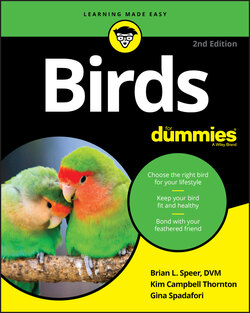Читать книгу Birds For Dummies - Gina Spadafori - Страница 96
PERCHES AU NATUREL
ОглавлениеIf you’re looking for a real bargain in bird equipment, search no further than the perch. No, not that plain pine dowel that came with the cage or that you can find by the scores at any pet-supply store. Some of the best perches around are free and easy to find. They grow on trees, you could say.
Tree branches make great perches. They add variety to your bird’s environment, help him maintain healthy feet and legs, and give him something else to rip up for entertainment. Most fruit and nut trees (almond, apple, prune, and all citrus) are fine to use, as are ash, elm, dogwood, and magnolia. If you can get your pruners on some manzanita, go for it — it’s a hard wood that can stand up to a lot of abuse. Try grapevines, too. And leave the bark on for your bird to peel off.
Cut branches to a length to fit in your cage, scrub and clean them well with detergent, rinse them, and let them dry in the sun. Check for insect egg pods, and if you find them, just break them off and throw them out before putting the branch in your pet’s cage. (If you don’t, you may find a zillion little bugs thinking it’s springtime in your home.)
You can entertain bigger parrots with scrap lumber. Just be sure you know the source of the wood. You don’t want to offer your bird pressure-treated lumber or wood that may be coated with preservatives or other potential toxins.
Think of perches as replaceable cage furnishings: When your bird rips them up, that’s great — it means he likes them! Replace them with more of the same when he destroys them. The extra labor and cost involved in replacing those perches is well worth the knowledge that, in your bird’s eyes, you’re doing a great job.
